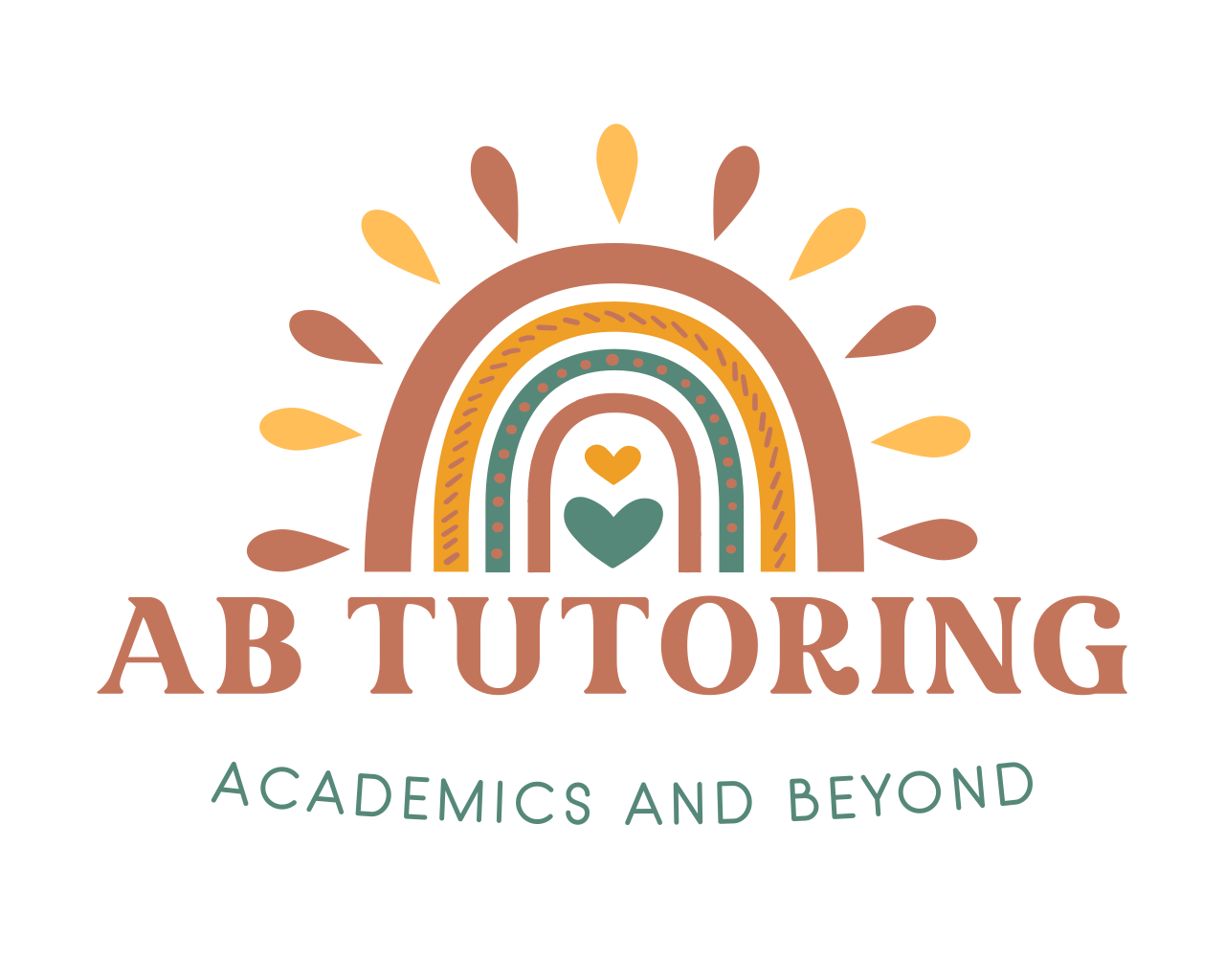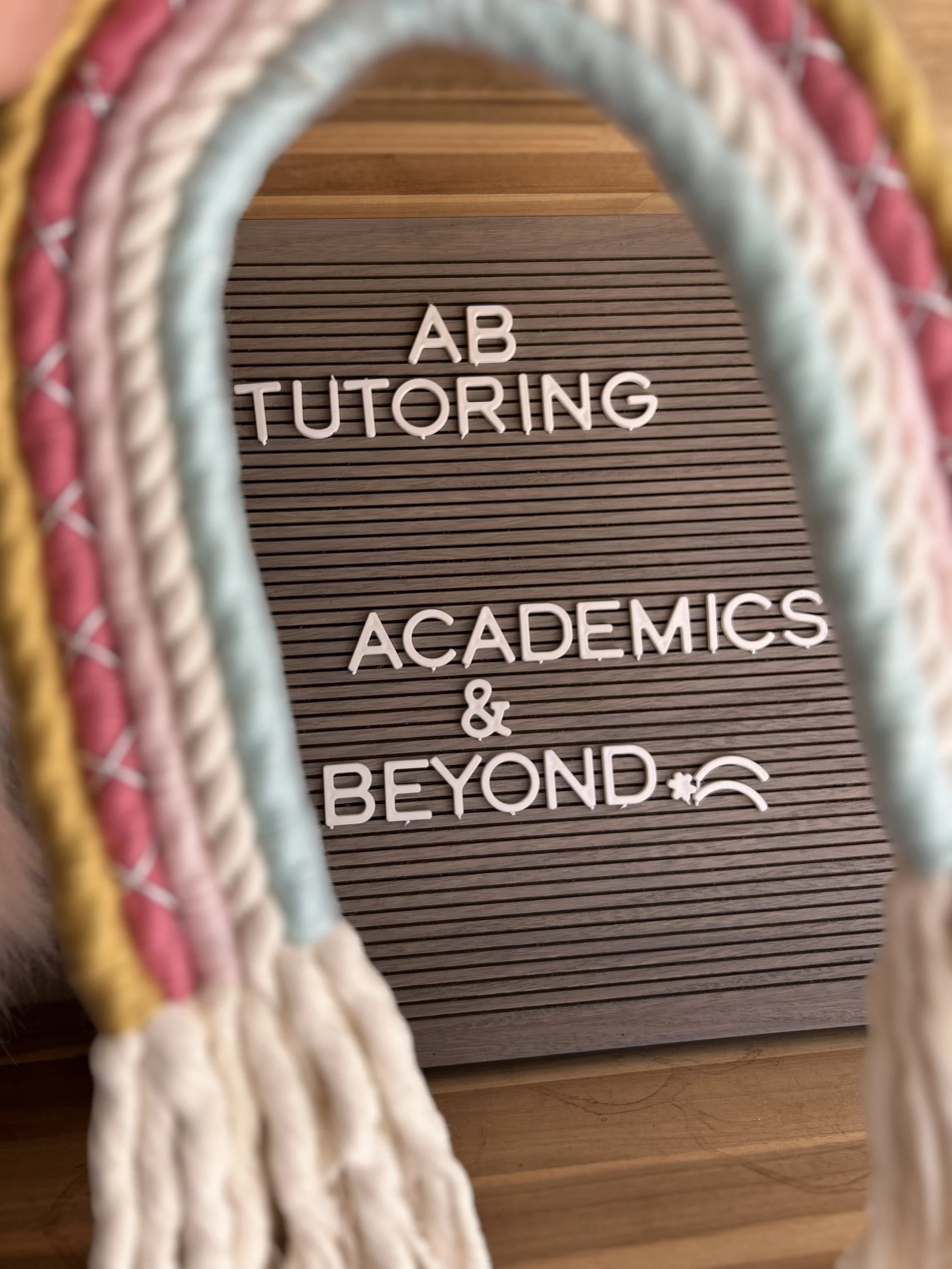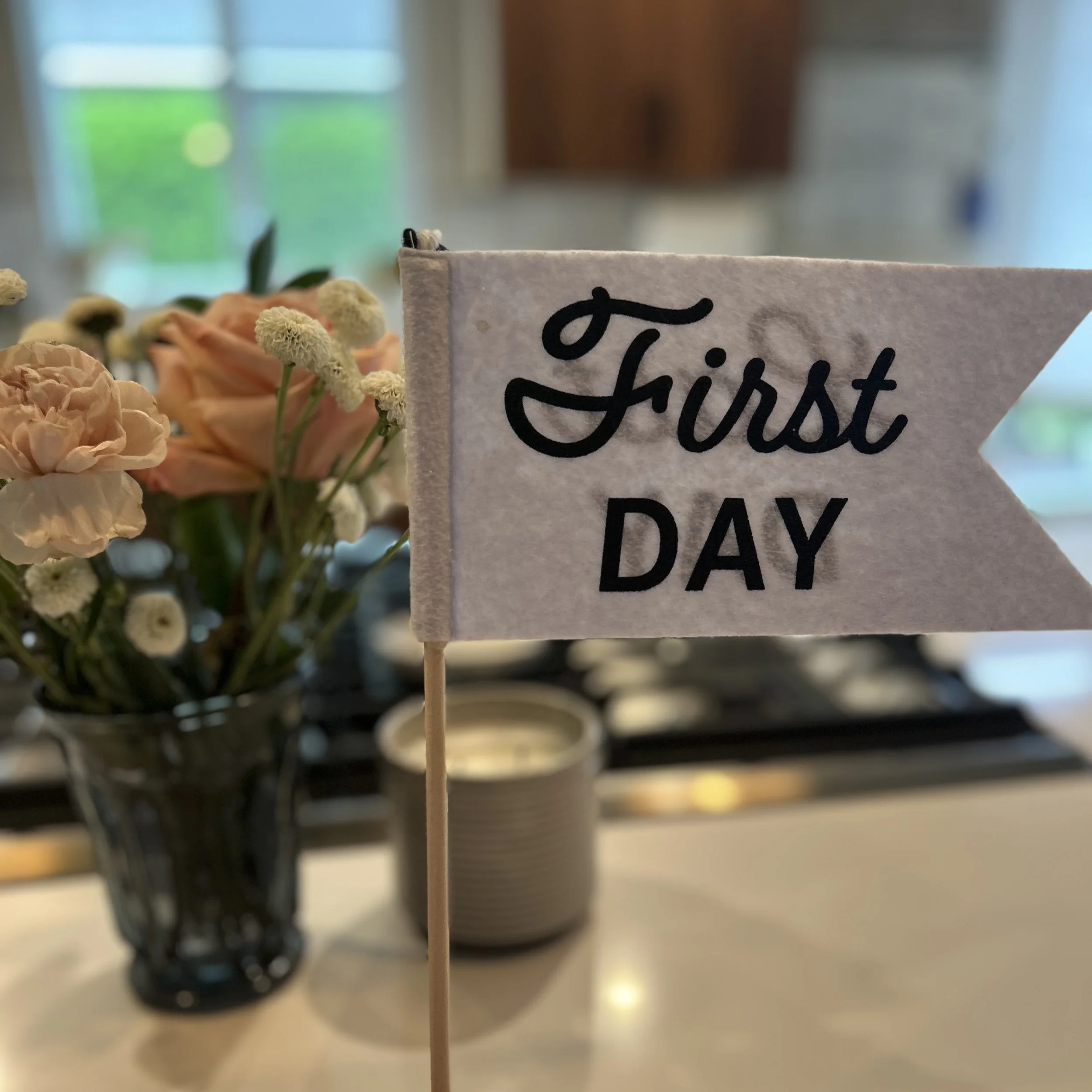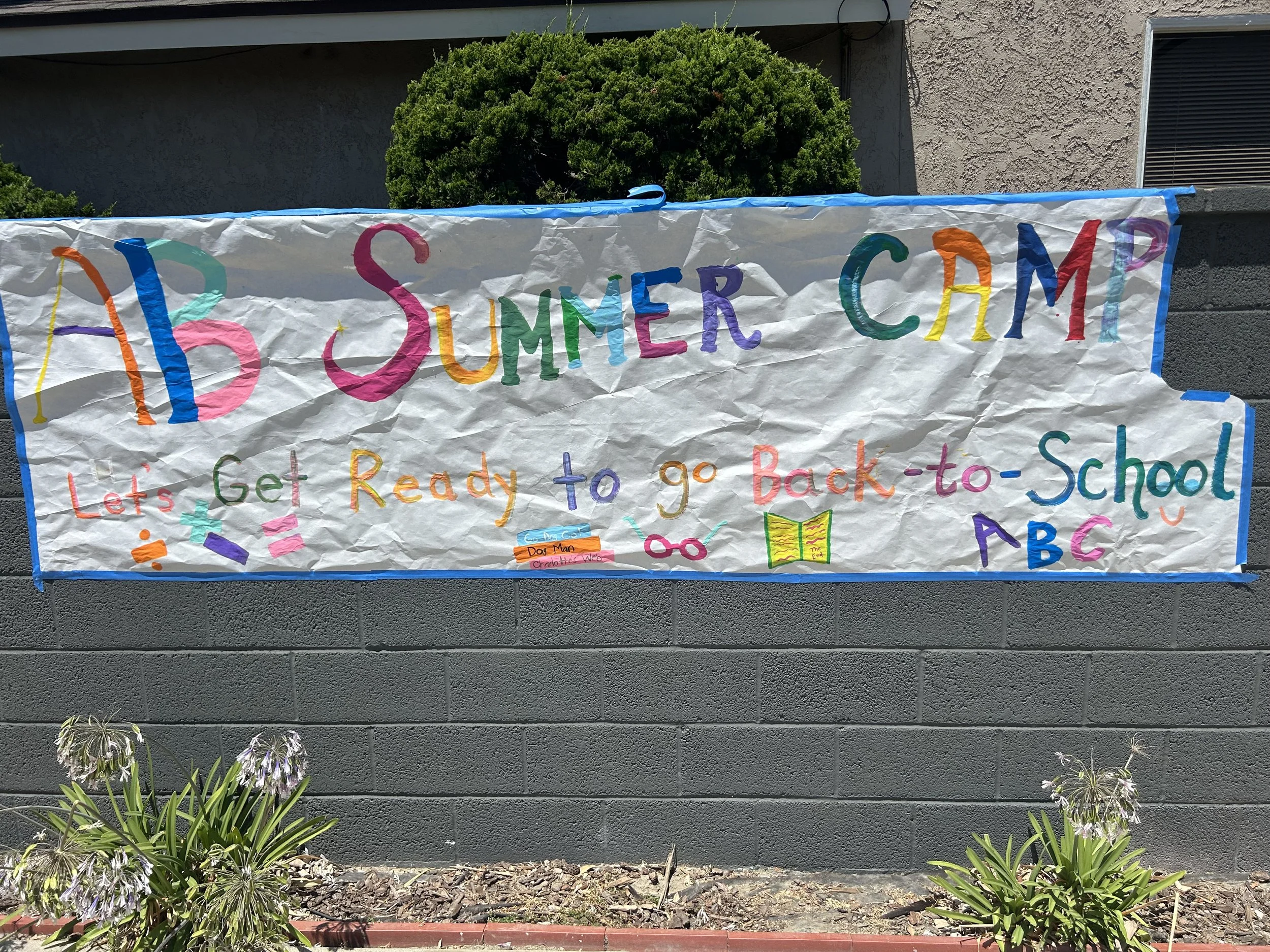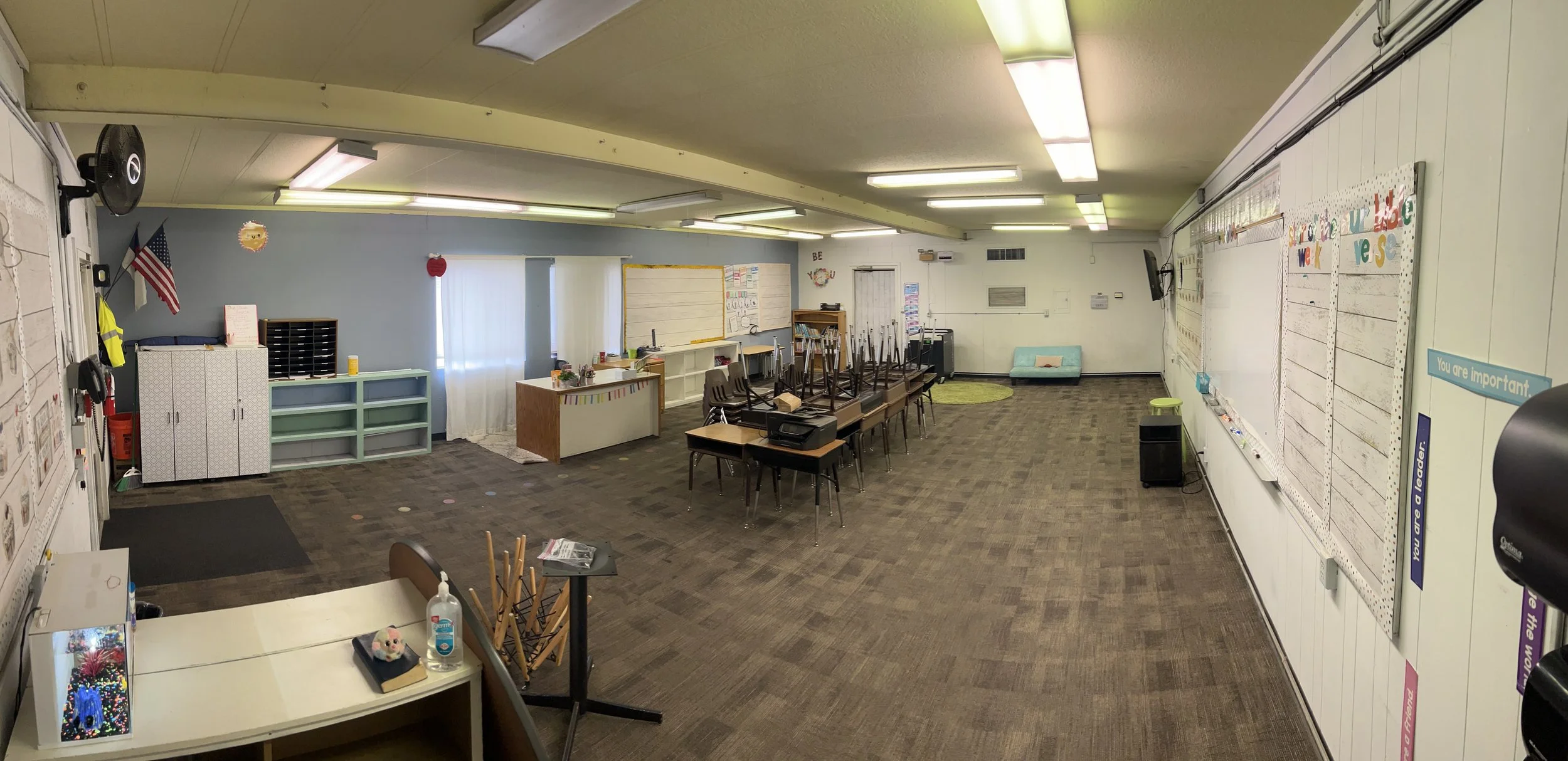Finding My Village: The Path to Becoming a Vendor
Becoming a vendor has brought some relationships full circle- reconnecting me with former students, families, and colleagues whose trust continues to lift me higher than I ever imagined.
When I first began the process of becoming a vendor, I really had no idea what it would entail, but I hoped it would open new doors for my tutoring business. What I didn’t know, was just how meaningful those doors would be once they opened. What I envisioned as a simple professional step quickly became something much deeper; a reminder of the community that has supported me, believed in me, and continued to lift me higher than I ever expected.
One of the special parts of this journey has been reconnecting with former students. Some that I taught years ago, yet the moment we sit down together again, it feels like no time has passed. Watching them grow, academically, emotionally, and as people, will forever be one of the greatest privileges of my career. Having them return to me with trust already built feels like coming full circle.
I’ve also been incredibly touched by referrals from past parents and coworkers. Every time someone shares my name, it’s not just a referral, it’s a vote of confidence. It’s someone saying, “I trust you with my kids, their learning, and their growth.” That trust means everything to me. I don’t take it lightly, and I carry it with me into every single session.
The phrase “it takes a village” has never felt truer. My village has shown up for me in ways I could never have imagined. Through kind words, freshly baked treats, recommendations, cups of coffee, encouragement, fresh flowers and opportunities I didn’t even know to hope for. This support has shaped my journey, and it’s something I’ll never stop being grateful for.
I know in my heart that this is just the beginning. Becoming a vendor is a milestone, yes, but it’s also a starting point for something bigger. I’m excited for the students I’ll meet, the families I’ll serve, and the connections that will continue to grow.
To everyone who has been part of this path: thank you. I am forever grateful. Here’s to all that’s ahead.
With gratitude,
Ashley
Why Parent-Teacher Conferences Matter (and 3 Ways AB Tutoring Can Help)
Parent–teacher conferences are the perfect time to learn more about your child’s growth so far. But once the meeting ends, it can be hard to know what steps to take next.
Why These Conversations Matter
Parent–teacher conferences are one of the most valuable checkpoints in your child’s school year. They give parents and teachers a chance to pause, look closely at progress, and make sure everyone is on the same page about what’s working and what might need extra support.
They’re also opportunities for partnership. Teachers share what they see in the classroom: learning habits, social interactions, and academic strengths or gaps. Parents bring valuable insight from home: what motivates their child, what they enjoy, and where they may feel stuck. When both perspectives come together, it creates a path forward. The goal isn’t just to raise grades, it’s to build confidence and momentum for the rest of the school year.
Ultimately, parent-teacher conferences are meant to be a positive and productive experience for parents and teachers alike. But, for many families, these short meetings can also feel a little overwhelming. Teachers often have limited time, and it can be hard to know what questions to ask or how to best follow up afterward. That’s where tutoring can play a powerful supporting role.
3 Ways AB Tutoring Can Support Families After Conferences
1. Turning Feedback into a Plan
After a conference, you might walk away with helpful notes but not know exactly where to begin. I help families take that teacher feedback and translate it into an actionable plan. Whether it’s strengthening reading fluency, improving writing organization, or brushing up on math problem-solving, I create lessons tailored to your child’s goals and learning style.
2. Bridging School and Home
Teachers often have specific strategies or curriculum expectations that can be tricky to reinforce at home. I collaborate closely with parents, and, when possible, align with classroom approaches, so your child receives consistent support in both environments. This connection helps students stay confident and reduces confusion about how to do things the “right” way.
3. Building Lasting Confidence
Sometimes, conferences reveal more than academic gaps. They can highlight areas where a child may feel anxious or unsure. My sessions are designed to rebuild confidence step by step. Through encouragement, clear explanations, and achievable goals, students learn to see themselves as capable learners again.
The Takeaway
Parent–teacher conferences shine a light on where your child stands today, but what you do next makes all the difference. With personalized support and clear communication, AB Tutoring helps bridge the gap between school expectations and your child’s individual needs, turning feedback into meaningful growth.
With gratitude,
Ashley
Ready to turn conference feedback into progress?
📚 Schedule a session or a quick consultation to discuss your child’s goals.
👉 Book a session or follow academicsandbeyondtutoring on Instagram
“How’s Tutoring Going?”
Tutoring has been a mix of joy, challenge, and growth. I’m working with amazing students, learning how to be my own boss, and embracing the blessings of being more present for my family.
This is the question I hear most often these days. And my answer is usually variations of the same: “It’s going good!”
Because it is.
But, it’s also so much more.
Tutoring has been an incredible mix of joy, challenge, and growth. I have been so blessed with students and families that I absolutely love working with. Sessions are productive, rewarding, and filled with those little lightbulb moments that I love so very much. I’m working hard to make a difference in their lives and in their education, and that in itself feels like success.
At the same time, running a business is a whole new adventure. I’m learning how to be my own boss. I’m learning that it’s okay if every hour of my day isn’t booked solid. And I’m learning that the perks that come with this work are deserved and more than okay.
Simple things like driving both girls to school in the morning without dropping them off an hour early just so I can be on time… that’s a blessing. Picking them up right at the bell instead of having them in after-school care until closing… that’s a blessing, too. And I say that with deep gratitude, because I know so many families depend on those programs (I was one of them for years), and I’m forever thankful I had that option when I needed it.
People ask me how it’s going because they genuinely care. They’re rooting for me. And I’m doing my best to root for myself. Some days I wish I was “contributing more” in the way I used to when I worked a full-time schedule, but I’ve realized that “contributing” looks different for everyone. For me, it looks like being present for my family, building something of my own, and serving students in a meaningful way.
So yes, tutoring is going good. Some days are better than others, but isn’t that true for life in general? At the end of the day, when I go to bed, I feel at peace. I feel happy, present, and fulfilled.
And if that’s not success, I don’t know what is.
With gratitude,
Ashley
This Week’s Journee…
This week one of my students reminded me there is always room for growth. Self-advocacy is something I still struggle with, so seeing her model it at such a young age was healing for me, too. Kids like her are going to change the world, not because they’re perfect, but because they’re brave enough to ask for what they need.
That’s what Academics and Beyond Tutoring is all about.
This week, something happened in a session that reminded me exactly why I started tutoring.
At the start of each session, I like to give my students a quick rundown of what we’ll be working on that day. Having a routine and clear expectations helps us stay focused and builds a sense of consistency. One of my students and I have been working on reading and reading comprehension, so I laid out our plan as usual.
When I finished, she looked at me and politely asked if we could also work on some strategies to help her with testing. With school right around the corner, she wanted to feel more confident going in.
In that moment, I realized something important. I never would have known this was a struggle for her if she hadn’t spoken up. It wasn’t part of the lesson I had planned, but because she advocated for herself, I was able to adjust. For her next few sessions, I have switched up my original plans and built in test-taking strategies and even created “mock tests” so she can practice in a safe, low-pressure way.
I was so proud of her. Not only for speaking up, but for trusting me enough to share what she really needed. Every one of my students is different. They each bring unique strengths, challenges, and needs into our time together. My goal has always been to meet them where they are, be their extra support system, and equip them with the tools they need to feel confident.
When my student spoke up, I felt so many emotions. Self-advocacy is something I still struggle with as an adult, so watching her model it reminded me how powerful it can be. Honestly, a small part of my inner child felt healed in that moment.
This younger generation often gets unfair criticism, but kids like her give me so much hope. She wasn’t afraid to ask for what she needed, and that confidence will carry her far beyond school. To me, that’s the heart of AB Tutoring; helping kids find their voice, grow their confidence, and know they’re capable of more than they realize.
With gratitude,
Ashley
The First Day of School…Without Me
The first day of school has always been a shared experience for my kids and me. New backpacks, fresh pencils, and the buzz of meeting our class. But this year, for the first time since my youngest started school, I’m not heading into my own classroom.
Today was the first time in years that I sent my girls off to school without also heading into my own first day.
No classroom waiting.
No supply collections.
No icebreaker games.
Just me, watching them walk into their new year while I stood on the outside for the very first time.
For so long, our first days of school were something we shared. They’d head to their new teachers, and I’d head to my new students. I’d juggle getting my kids ready with getting my own classroom ready, running on adrenaline and coffee, swept up in the happy chaos of it all.
But this year? This year I headed home to silence. Solitude.
And here’s the truth; it’s bittersweet.
A part of me is incredibly sad. This change feels like closing the door on a chapter I’ve loved. But another part of me is at peace. This is the new normal, and it’s exactly where I’m meant to be.
Now I have my own “honey do” list, something I’ve only ever been the creator of, never the recipient. I can (hopefully) volunteer in my girls’ classrooms and be even half the amazing help that other moms have always been to me in my old teaching life.
I knew this day was coming, but I didn’t know what it would feel like. Now I do, and it’s a little bit of everything. So, here’s to the first day of school and all the feelings it brings with it: joy, nostalgia, sadness, peace, and hope for the year ahead.
With gratitude,
Ashley
Trust. Try. Grow.
A behind-the-scenes journey of launching my very first camp, how fear turned into purpose, and how leading with heart has made all the difference. To every family who has believed in me so far: thank you.
When the idea of AB Summer Camp was suggested to me by a classroom mom turned friend, I could not wrap my head around where to even begin. But, I was also intrigued, and knew that if I put my mind to it, it could be something really special and fun.
The idea of turning my tutoring work into a full-scale week of enrichment, creativity, and connection felt like a big undertaking. What if I didn’t plan enough? What if the kids didn’t engage? What if no one had fun? But isn’t that how so many of life’s meaningful moments begin?
Whether it's a new school year, a new job, or starting a new routine with our families, the beginning is almost always the hardest part. We doubt ourselves. We second-guess. We wonder if we’re ready. And yet, somehow, once we step into it with heart and intention, things have a beautiful way of unfolding better than we imagined.
That’s exactly how this camp has been for me so far.
As soon as the first campers arrived yesterday and today, their bright eyes and eager energy reminded me why I do this work. Their laughter playing games, their pride when showing off a new skill, their creativity during an assignment; it’s all reminded me that when my heart is in something, it shows. I give my all to every project I take on, and this one has been no different.
This little dream of mine, to create a space where learning feels joyful, where kids are seen and supported, and where parents feel like they’ve found a true partner, has only grown stronger this summer and in this camp.
And it wouldn't be possible without you.
To the families who signed up, shared kind words, gave referrals, or simply showed up each day with your little learners ready to go: thank you. Your belief in me, and your trust in AB Tutoring, means more than I can say. You’ve trusted me with the most important part of your lives, your children, and I hold that responsibility with deep care and gratitude.
As I look ahead to the rest of summer and into the new school year, I’m reminded that we can do big things, even when they start with a shaky step. The uncertainty is part of it, but so is the joy, the growth, and the reminder that when you lead with heart, it all comes together.
With Gratitude,
Ashley
The Power (and Pressure) of Parenthood
The pressure of parenting is real. But so is its power; and sometimes the most important lessons come after the mess.
The other morning, my 8-year-old daughter was making herself a smoothie.
She carefully sliced up the strawberries, got out the frozen pineapple, poured in the milk, and even operated the blender all on her own. It wasn’t the world’s most complicated task, but I was proud because I try to practice what I preach when it comes to giving kids independence. Autonomy builds confidence, and confidence builds competence.
But then, as she went to pour her smoothie, it happened.
She moved too quickly, and in the blink of an eye, the blender blade fell out, followed by a tidal wave of smoothie erupting across the kitchen counter. Frozen pink goop, everywhere.
And I...overreacted.
I scolded her for being careless. I told her to clean it up. I let frustration take over instead of recognizing the moment for what it was: a simple mistake. A teaching moment.
The truth? I had been standing by the whole time. I’d offered to help. I told her, “Let me know if you need anything.” And when everything spilled, I instinctively snapped, “I said I would help! Why didn’t you ask?”
But here’s the thing: she didn’t know she would need help. She didn’t know the blade would fall out. At 8 years old, she was doing her best. And I was the one who missed the opportunity to be the adult I promised myself I would be.
I wasn’t raised in a home where parents apologized.
Parents got angry.
Parents reacted.
And then we all moved on.
I swore I would break that cycle. But there I was, doing exactly the thing I said I wouldn’t do.
So I took a breath. I gave myself a moment. And then...I apologized. And let me tell you- it was hard.
Because growing up, parents were never wrong. So to admit fault, to kneel down and say, “I’m sorry, I shouldn’t have spoken to you that way”, felt almost unnatural.
I expected her to shrug it off, say she was fine, and move on, like I was taught to do. But instead, she looked me straight in the eyes, smiled, and gave me the biggest hug.
And in that hug, she said so much without saying a word.
She told me it was okay.
She told me she forgave me.
She told me she knew that was difficult for me. And I truly believe she was proud of me. My eight year old.
I’ve had so many moms tell me that their kids act differently with me. That reading at home often leads to tears, that math practice turns into frustration and yelling. I hear things like, “Mrs. Brookshire doesn’t do it like that!” And I understand. Deeply.
Parenthood is hard.
It is messy; because we are messy.
And the pressures parents face today? Unparalleled.
But parenthood is also powerful.
It is the power to rewrite the script of our own childhood.
It is the power to show our children that adults can make mistakes, and more importantly, own them.
It is the power to say, “I was wrong,” and mean it.
I am far from perfect.
But I am proud to be the kind of parent, and educator, who is willing to learn from her kids. Who is trying every day to raise children who believe that saying sorry is not a weakness, but a strength.
Because the real power of parenthood isn’t in being right.
It’s in being real.
With Gratitude,
Ashley
The Story Behind the Name…
Why AB Tutoring Means So Much More
When I started my tutoring business, choosing a name felt both exciting and incredibly personal. I wanted something simple, but also meaningful. Something that would reflect me, what I believe in, and what I hope every child experiences when they walk into a session with me. That’s how AB Tutoring was born.
At first glance, it’s a straightforward play on my initials; Ashley Brookshire. Easy enough, right? But the truth is, it goes much deeper than that.
AB Tutoring is more than just my name. It also represents Academics and Beyond. A reminder of the two-fold mission that sits at the heart of my work.
Yes, I’m here to support children in their academic journeys. I believe in strong literacy foundations, building confidence through comprehension, and helping students reach the benchmarks they’re capable of achieving. But my commitment goes beyond test scores and report cards. Much of the work I do is about who these children are becoming. Not just as learners, but as people.
Every student I work with is unique. They are thinkers, dreamers, creators, and future leaders. They carry with them emotions, insecurities, joys, and stories that matter. I want them to know they are not just retainers of information. They are seen, heard, and loved in my space.
In a world that often rushes to measure success with numbers, AB Tutoring is my quiet rebellion. It’s where relationships come first, where every small person is treated like the big deal they truly are. It’s where “beyond” means checking in on how their day went, celebrating their kindness, or just giving them a place to feel proud of themselves again.
So yes, AB is me. But it’s also so much more than me. And that’s something I’ll always be proud to stand behind.
With Gratitude,
Ashley
From Classroom to Living Room: A New Chapter
From Classroom to Living Room: A New Chapter
I turned in my classroom keys today, and with them I left a piece of myself behind. Room 22 held so many memories and moments, big and small, and it’s so strange to know that it's no longer mine. For the first time in years, I won’t be spending my summer days laminating name tags, arranging desks into welcoming little groups, or planning those crucial first-week icebreakers. My classroom, a place that has been a second home to me and my students over the years, is now in the hands of another. Leaving it behind was one of the hardest things I’ve ever had to do.
To say I loved being a teacher feels like an understatement. I loved the "Aha!" moments when a tricky math concept finally clicked. I loved the sound of a classroom buzzing with collaborative energy in the mornings and the softer quieter focus in the afternoons. I loved watching everyone work together to solve problems and sing along when a favorite song would come on. Most of all, I loved my students. I loved their goofy jokes, their endless hugs, their unfiltered honesty, and their incredible capacity for growth and love. Being their teacher was a privilege.
But over the past couple of years, I started to see a pattern. I saw bright, capable children struggle to keep up, not because they couldn’t grasp the material, but because something else was holding them back. I saw frustration manifest as outbursts, anxiety lead to a refusal to try, and a lack of confidence create crippling self-doubt. The academic gaps were almost always downstream from a deeper, more personal struggle.
The truth is, a child who doesn't know how to manage their frustration can't persevere through a difficult long-division problem. A child who can't advocate for themselves won't ask for help when they're lost in a lesson. A child who doesn't believe in their own abilities will be too afraid of failure to even begin the assignment.
I saw a glaring need for more than just academic instruction. I saw a need for connection. A need for a space where students could understand their own emotions, develop empathy for others, and build the resilience to navigate the social world around them. The curriculum is packed, and the demands on teachers are immense. While we all do our best to weave social-emotional learning (SEL) into our days, there is often not enough time to give each child the focused, individual support they need.
And that’s where my new adventure begins—
I’m not leaving education behind. I’m just changing my address. Instead of a classroom of twenty-two, I’ll be working one-on-one with students as a private tutor. My mission is to bridge the gap I saw so clearly from the front of the classroom. I believe that academic success is inextricably linked to social and emotional well-being.
My approach won’t just be about mastering multiplication tables or recognizing sight words. It will be about building confidence, fostering a growth mindset, and developing self-awareness. We’ll celebrate the process, not just the product. We'll learn how to take on challenges with courage and how to treat ourselves with kindness when we stumble. We will build a foundation of emotional intelligence that will support not only a student's academic journey but their entire life.
It's a new chapter, for sure. It feels a little scary, a lot different, but full of purpose. I’m taking everything I loved about the classroom- the connection, the "aha" moments, the joy of watching a child blossom- and creating something new. So, let the new adventure begin.
With Gratitude,
Ashley
A Messy Desk is…
How clearing your space clears your mind —and tips on how tidying up one corner of life can transform the whole picture.
As a former classroom teacher turned private tutor, one of the first day of school principles I always tried to instill in my students was a self-made adage, "A messy desk is a messy mind".
Think about a classroom. When the inside of desks are cluttered with old papers, tiny notes, toy erasers, and an explosion of various writing utensils, it’s hard for anyone, especially a student, to concentrate on the task at hand. That visual chaos is a constant distraction, pulling their attention away from what truly matters, not to mention making it difficult to find what they need quickly. And here's the kicker: this isn't just about classroom desks. The exact same principle applies to our everyday lives.
As summer kicks off, I thought that writing about this topic could be helpful to parents and kids alike to keep everyone a little more sane in this season of lost routines.
___________________________________________________________
A messy room, a disorganized house, or a generally cluttered environment can significantly affect how we feel and our ability to get things done. It's not just about aesthetics; it's about psychology. When our surroundings are chaotic, our brains interpret that as a form of unfinished business. This can lead to:
Increased Stress and Anxiety: The visual overload can make us feel overwhelmed and out of control.
Reduced Focus and Productivity: Every misplaced item is a subtle nudge, diverting our attention and making it harder to concentrate on tasks.
Decreased Motivation: Facing a mountain of mess can be disheartening, making us less likely to even start a task.
Impaired Decision-Making: A cluttered space can make it harder to think clearly and make good choices.
Essentially, a messy external environment often mirrors, or even contributes to, a messy internal state.
Taming the Chaos:
The good news is that you don't need to become a minimalist overnight to experience the benefits of a more organized life. Even small, consistent efforts can make a big difference. Here are some genuine and helpful ways to start eliminating mess from your day-to-day life:
1. Start Small, Think Big
Don't try to tackle your entire house in one go. Pick one small area – your desk, a single drawer, or even just your nightstand. Declutter that space completely. The sense of accomplishment will motivate you to move on to the next area.
2. The "One-Minute Rule"
If a task takes less than a minute to complete, do it immediately. This could be putting away a dish after you've used it, hanging up your jacket when you come inside, or putting your keys in their designated spot. These tiny actions prevent small messes from becoming big ones.
3. Everything Needs a Home
This is a golden rule of organization. If an item doesn't have a designated place, it will inevitably end up contributing to clutter. Take some time to identify a "home" for everything you own, and then, crucially, always put things back in their homes.
4. The "One In, One Out" Rule
When you buy something new, especially in categories prone to accumulation (clothes, books, kitchen gadgets), consider donating or getting rid of something similar you already own. This prevents endless accumulation.
5. Schedule Regular Decluttering Sessions
Just like you schedule appointments or workouts, schedule short, regular decluttering sessions. Even 15-30 minutes once a week can make a significant impact. Use this time to put things away, sort mail, and tidy up.
6. Digitize When Possible
Old papers, receipts, and documents can quickly pile up. Explore options for digitizing these items. Apps like Adobe Scan or your phone's camera can turn physical documents into digital files, reducing paper clutter.
7. Embrace Vertical Space
Don't forget about shelves, wall-mounted organizers, and drawer dividers. Utilizing vertical space and internal organizing solutions can significantly increase your storage capacity without expanding your footprint.
8. Be Mindful of "Landing Zones"
Identify areas in your home that tend to become dumping grounds (e.g., your kitchen counter, the entryway table). These are often "landing zones" where items accumulate. Be extra diligent about keeping these areas clear and implementing the "everything has a home" rule here.
Creating a more organized environment isn't about perfection; it's about creating a space that supports your well-being and productivity. When your physical space is clearer, you'll often find that your mind feels clearer too. So, take a deep breath, pick one small area, and start decluttering your way to a calmer, more focused you.
What's one small change you can make today to bring more order to your environment?
How to Know If Your Child Needs a Tutor: 5 Key Signs
Before the Struggle Gets Real: 5 Signs It’s Time for a Tutor
Most of you know that I’ve had the privilege of being a classroom teacher and supporting children both in large groups and one-on-one. One thing I know for sure: every child learns at their own pace, and sometimes they just need a little extra support to thrive.
If you’re wondering whether your child might benefit from a tutor, here are five signs to look for- based on what I’ve seen in the classroom and heard from parents.
1. Homework Is Taking Way Too Long (and Ends in Frustration)
If your child spends hours on what should be a 30-minute assignment—or if homework time consistently ends in tears, arguments, or shutdowns—it may be a red flag.
In each new grade level, students are developing independence and stamina. If your child avoids assignments or needs constant help to get through them, a tutor can provide the targeted instruction and confidence boost needed to make things click—and ease the stress on everyone at home.
2. They Say Things Like “I’m Just Not Good at Math”
It’s heartbreaking when a child starts believing they aren’t smart. When I taught 3rd grade, students would say things like, “I’m bad at reading,” or “I’m not as smart as everyone else,” and I even heard negative self-talk creep in as early as first grade.
When kids start to label themselves or view certain subjects with a negative lens, it is often a signal that they are struggling more than they let on. A tutor can gently rebuild confidence by reteaching concepts and celebrating small wins. A positive mindset is just as important as academic progress!
3. The Teacher Has Expressed Concerns, But You’re Not Sure What to Do Next
Maybe your child’s teacher mentioned that your student is falling behind or having difficulty meeting grade-level expectations, and it can be overwhelming to know what steps to take or how to help at home.
Tutors can bridge that gap between school and home by aligning tutoring sessions with what’s happening in the classroom, providing personalized support that complements school goals.
4. They Struggle with Focus or Following Directions
This doesn’t always mean a child has ADHD or a learning issue—it might just mean they need more personalized guidance and fewer distractions than a busy classroom can offer. If your child has trouble starting tasks, staying on topic, or following multi-step directions, personalized tutoring might help.
In private one-on-one sessions, tailoring the pace and approach to your child’s learning style helps build focus, stamina, and ownership of their learning.
5. You Just Want to Prevent Gaps Before They Grow
Tutoring isn’t just for kids who are struggling—it’s also a powerful tool for building momentum! Some families seek tutoring to build confidence, keep up momentum during transitions (like moving from 2nd to 3rd grade) or to prevent the dreaded "summer slide."
I am dedicated to helping kids stay sharp, feel confident, and start the new school year strong. Proactive support now can make a big difference later.
💡 Final Thoughts
As someone who has sat at the front of the classroom, I know what’s expected of students today—and how hard it is to meet every child’s needs in a large group. Tutoring is not about “fixing" your child; it’s about giving them the space, strategies, and encouragement they need to feel capable. It can truly be transformative—not just academically, but emotionally.
Tutoring gives your child:
A safe space to ask questions
The freedom to learn at their own pace
A trusted adult who believes in their potential
If you’re curious whether tutoring might help your child, I’m always happy to chat or do a quick learning check-in. Sometimes, a little support goes a long way!
Faith Over Fear
Finding Peace in the Unknown
It’s been exactly one month since my final “last day of school”. I knew then that I wouldn’t be going back to teach in Room 22, and on that day, I felt a swirl of emotions; gratitude, sadness, excitement, and, if I’m being honest, a little fear. Stepping away from something I’ve known and loved for years- my classroom, my students, the rhythm of the school year- wasn’t easy. But beneath all the noise of what-ifs and maybes, there was a quiet but steady voice reminding me: Faith over fear.
That phrase became our school’s unofficial motto back in 2020, during the uncertain days of distance learning and daily pivots that COVID brought with it. We clung to it like a life raft. “Faith over fear” didn’t make hard things go away, but it helped us face them with strength, steadiness, and a deeper belief that we weren’t walking through the chaos alone. It’s a phrase that settled deep into my heart, and I’ve carried it with me ever since.
Faith has always played a foundational role in my life. It’s the lens through which I’ve made many of my biggest decisions, including this one. Leaving a secure, predictable teaching career to start my own private tutoring business. That kind of leap doesn’t come without late-night doubts or moments of second-guessing. But every time I start to spiral, I come back to the truth that’s anchored me again and again: when I move in faith, I’m never really falling; I’m being led.
I want to be clear. This post isn’t about pushing a particular belief system or assuming that everyone shares mine. I know we all draw strength from different places. Some find it in their faith, others in family, nature, meditation, or simply in the quiet knowing that they've walked through hard things before and come out stronger. However you define your source of strength, I believe in honoring it.
For me, my faith reminds me that I’m part of something bigger than myself, that I’m not in control of everything (even though I often try to be!), and that when I choose to trust instead of fear, I find peace. Not perfection. Not ease. But peace.
Starting AB Tutoring is a leap, yes. But, it’s also an act of obedience and hope. I truly believe that this next chapter will be full of growth, not just for me, but for every student and family I get to serve. I didn’t leave the classroom because I was burnt out or tired. I left because I felt called to reach kids in a different way, to support families more personally, and to use my gifts in a space where relationships come first.
So, if you're standing at the edge of something uncertain, I hope you know this: it’s okay to be nervous. It’s okay to not have all the answers. I certainly don't. But fear doesn’t get the final say. You do. I do. Whether it’s launching a new business, making a change for your child, or simply taking one brave step toward something unfamiliar- you are capable, you are seen, and you are not alone.
Here’s to choosing faith over fear, again and again.
With Gratitude,
Ashley

